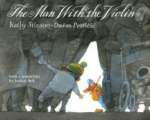
The Man with the Violin
Written by Kathy Stinson
Illustrated by Dušan Petričić
Annick Press, 2013, 32 pp.
ISBN-13: 978-1554515653
Dylan and his mother are hurrying to catch their subway train when Dylan hears beautiful musical notes that “soar to the ceiling” and “swoop to the floor” and tickle the hairs on the back of his neck. Dylan scans the crowd and sees a man in a blue baseball cap playing a violin. The 10-year-old is mesmerized by the music and begs his mother to stop so they can listen. Oblivious to the music, his mother pulls Dylan down the escalator to the train. Throughout the day the music lingers in Dylan’s head. That night, listening to the radio at home, Dylan hears the music again. The announcer explains that Joshua Bell, “one of the finest musicians in the world” played in the train station that day, “yet few people listened even for a minute.” Dylan’s mother realizes they should have earlier taken time to listen and so they listen and dance together.
The Man with the Violin is based on the renowned violinist Joshua Bell who, in 2007, played his Stradivarius in a metro station in Washington, D.C. Though people all over the world pay large amounts of money to hear him play in a concert hall, Bell collected only $37.14 in the violin case that lay open at the train station. The story reminds readers to stop and appreciate the serendipitous moments in life and to pay attention to people who surround them, no matter what their circumstances appear to be.
Canadian author Kathy Stinson has written a range of books from picture to young adult and from realistic and historical fiction to horror stories. Her preschool books, Red is Best (2012) and Big or Little (1983, 2009) received international acclaim. When she heard about the Joshua Bell event and that the children who passed by wanted to stop and listen but were hurried on by their accompanying adults, she knew there was a story to tell. Her written text has a “music” of its own, with its rich descriptions, alliterations, onomatopoeia, and varying sentence patterns. She concludes the book with a short biography of Bell, a brief description of the subway event, and a postscript written by Joshua Bell—all attesting to the authenticity of this story. The back cover indicates that a portion of the book’s proceeds are being donated to a “charity that promotes engagement with music among young people.”
Dušan Petričić, a Yugoslavian born Canadian illustrator, has won many awards for his work. He effectively and skillfully portrays this musical story with graphite and watercolor. Through the use of color contrast, for example, he highlights what Dylan notices through color while what Dylan’s mother sees is left white. He also contrasts the lyrical flow of Bell’s music, drawn in flowing lines that sweep Dylan in, with the jagged zig-zag lines of the sounds of the trains and people talking. In a text set on music, The Man with the Violin might be paired with books such as Music for the End of Time (Jen Bryant, 2005) and The Cello of Mr. O (Jane Cutler, 1999). It would also work well in a text set on respecting and valuing those who seem different, paired with such books as Each Kindness (Jacqueline Woodson, 2012) and Crow Boy (Taro Yashima, 1964).
Prisca Martens, Towson University
WOW Review, Volume VII, Issue 1 by Worlds of Words is licensed under a Creative Commons Attribution-NonCommercial-ShareAlike 4.0 International License. Based on work at https://wowlit.org/on-line-publications/review/vii-1/
